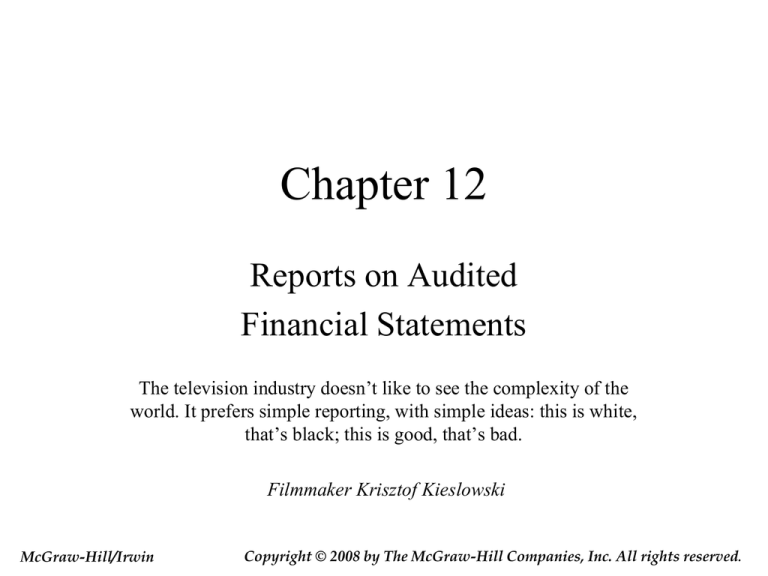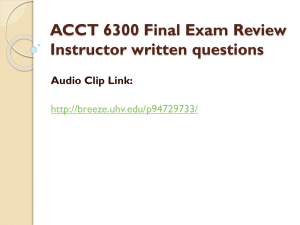
Chapter 12
Reports on Audited
Financial Statements
The television industry doesn’t like to see the complexity of the
world. It prefers simple reporting, with simple ideas: this is white,
that’s black; this is good, that’s bad.
Filmmaker Krisztof Kieslowski
McGraw-Hill/Irwin
Copyright © 2008 by The McGraw-Hill Companies, Inc. All rights reserved.
12-2
Reports Accompanying
Financial Statements
• Prepared by Auditor
– Opinion on financial statements and related
disclosures: Are they presented per GAAP?
– Opinion on internal control over financial
reporting: Is it effective?
• Prepared by Management
– Opinion on internal control over financial
reporting: Is it effective?
The Purpose of the Auditors’
Report
• Are F/S in conformity with GAAP?
– Provide indication of what the F/S would be like if GAAP were
followed
– Provide any entity-omitted disclosures
• Any unusual aspects of the audit examination?
– Scope limitations
– Division of responsibility
• Any unusual matters related to the entity?
– Going-concern uncertainty
– Consistency
– Emphasis of a matter
12-3
12-4
Types of Auditors’ Reports
• Standard report
– Expresses an unqualified opinion
• Unqualified opinion with modified wording
– F/S are in conformity with GAAP
– Difference between this and standard report is that additional
matters are disclosed in report
• Qualified opinion
– “Except for” some matter, F/S are in conformity with GAAP
• Adverse opinion
– F/S are not in conformity with GAAP
• Disclaimer of opinion
– No opinion is issued by auditors
12-5
The Standard Report (Paragraphs)
• Introductory
– F/S and years examined
– Responsibility of auditors and management
• Scope
– Audit conducted in accordance with PCAOB standards
– Description of an audit (specific references to “test basis,”
“materiality,” and “significant estimates”)
– Audit provides reasonable assurance
• Opinion
– Are F/S presented in conformity with GAAP?
• Internal Control
– References examination, report, and opinion on internal control
12-6
The Standard Report (Other Elements)
• Title includes the word “independent”
• Addressed to the client (normally,
shareholders and board)
• Dated on the audit completion date
• Signed by the accounting firm
12-7
Independent Auditors’ Report (AS 5)
Report Title
Report Address
Introductory Paragraph
Scope Paragraph
Opinion Paragraph
Internal Control
Paragraph
Signature
Report Date
Report of Independent Registered Public Accounting Firm
To the Board of Directors and Shareholders
APOLLO SHOES, INC.
We have audited the accompanying balance sheets of APOLLO SHOES, INC. as of December 31, 2008 and
2007, and the related statements of income, comprehensive income, shareholders’ equity, and cash flows for each
of the years in the three-year period ended December 31, 2008. These financial statements are the responsibility
of APOLLO SHOES, INC.'s management. Our responsibility is to express an opinion on these financial
statements based on our audits.
We conducted our audits in accordance with the standards of the Public Company Accounting Oversight Board
(United States). Those standards require that we plan and perform the audit to obtain reasonable assurance about
whether the financial statements are free of material misstatement. An audit includes examining, on a test basis,
evidence supporting the amounts and disclosures in the financial statements. An audit also includes assessing the
accounting principles used and significant estimates made by management, as well as evaluating the overall
financial statement presentation. We believe that our audits provide a reasonable basis for our opinion.
In our opinion, the financial statements referred to above present fairly, in all material respects, the financial
position of APOLLO SHOES, INC. as of December 31, 2008 and 2007, and the results of its operations and its
cash flows for each of the years in the three-year period ended December 31, 2008, in conformity with
accounting principles generally accepted in the United States of America.
We also have audited, in accordance with the standards of the Public Company Accounting Oversight Board
(United States), APOLLO SHOES, INC.’S internal control over financial reporting as of December 31, 2008,
based on criteria established in Internal Control — Integrated Framework issued by the Committee of
Sponsoring Organizations of the Treadway Commission and our report dated January 29, 2009 expressed an
unqualified opinion thereon.
Smith & Smith, CPAs
January 29, 2009
12-8
Reporting Options
• Separate reports on F/S and I/C
– Each of the reports would reference other report
• Combined report on F/S and I/C
12-9
Reasons to Issue an Other
than Standard Report
• Departure from GAAP
– Qualified or adverse opinion, depending upon materiality and pervasiveness.
• Unable to conduct the audit in accordance with GAAS
(PCAOB Standards)
– Scope limitation: Qualified or disclaimer of opinion, depending upon materiality
and pervasiveness
• Auditors wish to bring matters to readers’ attention
(unqualified with additional explanation)
–
–
–
–
–
Consistency
Going-concern uncertainty
Rule 203 departures from GAAP
Division of responsibility
Emphasis of a matter
12-10
GAAP Departures
12-11
Qualified (“Except for ...”) Opinion
• Issued when departure is material, yet not
pervasive
• Report Modifications:
– Introductory and scope paragraphs remain the same
– Add explanatory paragraph preceding the opinion
paragraph explaining departure and detailing $ amounts
involved
– Modify opinion paragraph (“In our opinion, except for
the matter discussed in the preceding paragraph,….”)
12-12
Adverse Opinion
• Issued when statements are “so lacking in
fairness” that a qualified opinion would be
misleading (i.e., a serious, pervasive departure
from GAAP).
• Report Modifications:
– Introductory and scope paragraphs remain the same
– Add explanatory paragraph preceding the opinion
paragraph explaining the departure and detailing $
amounts involved
– Change opinion paragraph (“financial statements do not
present fairly”)
12-13
GAAS Departures
12-14
Scope Limitation: Qualified (“Except for ...”) Opinion
• Issued when scope limitations are material, but not
pervasive
• Report Modifications:
– Introductory paragraph remains the same
– Scope paragraph: “Except as discussed in the following
paragraph [the scope limitation], we conducted our audit…”
– Add explanatory paragraph preceding the opinion paragraph
describing the scope limitation
– Modify opinion paragraph (“In our opinion, except for”)
• Key is the inability of auditors to identify potential misstatements
because of the scope limitation, not the limitation itself
Scope Limitation: Disclaimer of
Opinion
12-15
• Pervasive scope limitation, usually client-imposed
– Significance of the limitation is such that auditors cannot gather
sufficient appropriate evidence to form an opinion
• Report Modifications:
– Introductory paragraph: (“We were engaged to audit ….”; omit
auditors’ responsibility)
– Omit scope paragraph
– Add explanatory paragraph describing scope limitation
– Change opinion paragraph (“…we do not express an opinion….”)
• May still issue opinion on internal control if no scope limitation on that
examination
12-16
Lack of Independence
• Scenario: Auditors begin engagement but
independence subsequently compromised
• Report
– Single paragraph
– Indicates auditors are not independent
– Does not indicate why independence lacking
12-17
Unqualified Opinion
with Explanatory Language
•
•
•
•
•
Consistency
Going-Concern Uncertainties
Rule 203: Justified Departures from GAAP
Division of Responsibility
Emphasis of a matter
12-18
Consistency
• Relates to the changes in:
–
–
–
–
–
Accounting principles (GAAP to GAAP)
Form of reporting entity
Accounting principles (non-GAAP to GAAP)
Accounting principle inseparable from changes in estimates
Presentation and definitions in Statement of Cash Flows
• Add explanatory paragraph following the opinion
paragraph
• May issue a qualified opinion (GAAP departure) if:
– Change is not justified
– Change is not accounted for in conformity with GAAP
12-19
Going-Concern Uncertainties
• Auditors are responsible to evaluate whether
substantial doubt exists about ability of entity to
continue in existence for one year beyond date of
F/S
• Options
– Add explanatory paragraph following opinion
paragraph (still unqualified opinion)
– If serious uncertainty, may issue disclaimer of opinion
– Modified language must include the words substantial
doubt and going concern
12-20
Rule 203 Report
• Rule 203 allows for unqualified opinions on
F/S that are not in conformity with GAAP if
GAAP would be misleading
• Add explanatory paragraph either preceding
or following the opinion paragraph
12-21
Division of Responsibility
12-22
Reference to Other Auditors
• Principal auditors should
– Verify other auditors’ reputation and independence
– Communicate and coordinate with other auditors
• Options
– Take responsibility for work: Standard report
– Name other auditors
• Present report of other auditors, only with their permission
– Refer to other auditors
• Modify introductory, scope, and opinion paragraphs of report
• Still express unqualified opinion
12-23
Emphasis of a matter
• Call user attention to important matters
• Add explanatory paragraph after opinion
paragraph discussing the matter
12-24
Other Issues Affecting
Auditors’ Report
• Association with unaudited F/S
• Comparative F/S
• Information accompanying F/S
– Condensed F/S
– “Other information”
– Quarterly and supplemental information
12-25
Association with Unaudited F/S
• Auditors permit use of name in communication
• Issue disclaimer of opinion (one paragraph)
– Do not mention auditing procedures performed
– Must identify any known departures from GAAP in the
report
– Should cover all unaudited prior-years’ financial
statements
12-26
Comparative F/S
• Continuing Auditors
– Update opinion by considering if previously-issued
opinions still appropriate
– If previously-issued opinions not appropriate, revise
opinion in current report
• Predecessor auditors
– With permission, successors may present reissued report
on prior-years’ F/S along with their report on current F/S
– If predecessors’ report not presented, successors’ report
must reference predecessors’ report and opinion on prioryears’ F/S
12-27
Information Accompanying F/S
• Types
– Condensed F/S
– “Other information” presented by management
– Quarterly and Supplemental
• Determine whether information is inconsistent
with F/S, misstated, or omitted
• Reporting
– Issues with information do not affect opinion on F/S
– Expand auditors’ report to discuss issues
12-28
Reporting Summary






